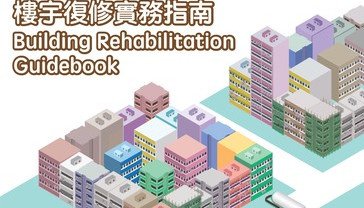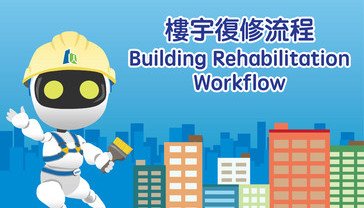Department:Buildings Department
On Dangerous/Defective Buildings (Section 26/26A)
As regards any building that have become dangerous, whether due to external causes, fair wear and tear or prolonged disrepair, the Building Authority (BD) may issue a statutory order (commonly known as ‘repair order’) to owners of the building decreeing that appropriate remedies (Section 26 (1) and (2)) be implemented in respect of the actual circumstances and legal requirements, for example repair works, and erection of supporting pillars or balustrades.
If the condition of the building is deemed as unsatisfactory but not dangerous, BD may nonetheless issue a statutory order (commonly known as ‘inspection order’) directing owners of the building to engage an Authorised Person for inspection on the prescribed parts of the building with suggested remedial works tabled for approval by BD to be carried out (Section 26A (1) and (2)). In addition to inspection of the entire building, canopies and balcony structures are both common prescribed parts.
BD may issue an Investigation Order requiring the appointment of an Authorized Person (AP) to carry out an investigation on the structural conditions and defects of a building or its drainage system.
On Drainage (Section 28)
Drains or sewers of buildings are also under the supervision of the Building Authority (the BD). When the drainage system of a building is deemed insufficient or is found to be in a defective or insanitary condition, BD will issue a relevant statutory order to the owners concerned decreeing that the prescribed drainage works to be done. Owners may be required to appoint an Authorised Person for inspection on the drains or sewers of the building with suggested remedial works tabled for BD’s approval for their execution (Section 28 (3)).
On Unauthorised Building Works (UBW) (Section 24)
All building works at private buildings (excluding public housing), regardless if they concern additional or renovated structures, should only be carried out with the approval obtained from the Building Authority (i.e. the BD). Such procedure is commonly known as ‘submission of building plans’. All building works, except minor works in compliance with simplified requirements (abbr. minor works) and exempted works, carried out without prior approval by the BD will be deemed ‘unauthorised building works’ (abbr. UBW). Common UBWs include rooftop structures, enclosed balconies and removal of protected lobbies.
The BD will issue a statutory order (commonly known as ‘removal order’) to owners concerned decreeing the removal or rectification of UBWs to be done in compliance with provisions of applicable ordinances (Section 24 (1)), such as the removal of rooftop structures or restoration of protected lobbies. If the prescribed removal or rectification works are not of a substantial scale or do not involve complex structures, they may be carried out in compliance with regulations of minor works by qualified contractors engaged by the owners; otherwise, they must be carried out under the supervision of qualified building professionals.
On Mandatory Building Inspection Scheme (MBIS) and Mandatory Window Inspection Scheme (MWIS)
(Sections 30B and 30C)
Pursuant to the MBIS, a statutory notice (commonly known as ‘mandatory building inspection notice’) will be served on owners of private buildings aged 30 years or above (except domestic buildings not exceeding 3 storeys) by the Building Authority (i.e. the BD) requiring the inspection of common parts, external walls and projections or signboards conducted by a registered inspector, who shall also undertake the supervision of prescribed repair works carried out in accordance with the inspection report (Section 30B (3)).
The scope of prescribed inspection (and repair works) include: structural components (e.g. beams), fire safety components (e.g. fire rated doors), drainage system (e.g. pipes) and identification of existing UBWs.
Meanwhile, the MWIS targets private buildings aged 10 years or above (except residential buildings not exceeding 3 storeys), where owners who have received the statutory notice (commonly known as ‘mandatory window inspection notice’) shall engage a qualified person for the prescribed inspection of all windows of the building. Any prescribed repair works deemed necessary shall be carried out by a registered contractor engaged by the owners under the supervision of the qualified person (Section 30C (3)).
Upon compliance with the mandatory window inspection notice, notice in respect of the same windows will not be served in 5 years from the issue date of the original order.
On dangerous hillside (Section 27A)
With regards to any slope or retaining wall on private land whose condition is deemed unsatisfactory or liable to the risk of overall or partial collapse with danger of causing injury to persons or damage to property, the Building Authority (i.e. the BD) may issue orders in writing to the persons responsible for such land (the owners in general circumstances) decreeing designated reinforcement or remedial works to be done; or, if need be, prescribing the appointment of one or more Authorised Persons, registered structural engineers or registered geotechnical engineers for relevant inspection and implementation of appropriate works in accordance with the inspection results and proposal approved (Section 27A (1) and (2)).
Department:Buildings Department & Fire Services Department
The purpose of the Ordinance is to administer the improvement of existing fire safety measures in old buildings with potential risks in fire safety design with a view to protecting owners, occupants and visitors therein.
Fire safety measures covered by the Ordinance involve ‘fire safety provisions’ and ‘fire service installations and equipment’, whose enforcement falls within the responsibility of the Director of Buildings and the Director of Fire Services respectively. Under general circumstances, ‘Fire Safety Direction’ will be jointly issued by the BD and the FSD to owners or occupants of target buildings prescribing improvement requirements for fire safety measures to facilitate the relevant works to be done.
Fire Safety Provisions
The function of fire safety provision (also known as fire resistance construction) is to safeguard means of escape in case of fire while preventing its spread, thus ensuring sufficient time for safe evacuation and minimising loss of property. Common improvement works for fire resistance construction in compliance with requirements of the Ordinance include:
- Fire rated door
Performance requirements stipulated for the design of fire rated doors were loose in the past due to the misconception that doors made with solid wood offer sufficient fire resistance. In view of the substantial improvement in the fire resisting performance of new generation fire rate doors, the following requirements on newly installed fire doors are stipulated as follows:
• Solid timber construction or in accordance with the construction specified in the test report.
• Firmly implanted to the surrounding walls without any visible gaps.
• Installed with door closer.
• Intumescent strips installed on the door leaf/frame (applicable to solid wooden doors in general).
- Fixed light
In the past, the materials and design of windows along escape routes were not regulated. While aluminium and/or movable windows are the common choice for replacement, they cannot protect means of escape from fire and smoke. To ensure safe means of escape, BD demands owners of old buildings to replace windows that are not fire-resistant. The general requirements are as follows:
• Fixed window structures (cannot be left opened at will);
• Stainless steel or galvanised carbon steel window frames; and
• Fire-resistant window glasses.
- Enclosures to non-emergency services
In old buildings, non-emergency service facilities such as electrical wires, electricity meters and telecommunication facilities are often roughly fixed along staircases and corridors, which form the only escape route. In case of fire, these non-emergency service facilities may facilitate the spread of fire towards the escape route, thus posing a threat to persons in evacuation.
Since the addition of engine rooms and cable troughs to old buildings is not possible the Ordinance stipulates that owners shall enclose non-emergency service facilities along the escape route with fire-resistant materials to enhance the protection of occupants and users of these buildings. The general requirements for the installation of additional enclosures are as follows:
• The escape route must have a minimum clearance of 2 metres in width and a height after enclosure.
• The enclosures for non-emergency electrical installations/electricity facilities must be installed in compliance with the Electricity Ordinance
and Supply Rules of power companies.
Upon completion of the applicable improvement works, the owners should inform BD for inspection and submit copies of certificates/test reports/assessment reports on the relevant materials for compliance verification.
Fire Service Installations & Equipment
The majority of old buildings had no fire service installations or equipment installed at the time of their construction. As such, it is not uncommon for small fire to build up into a much greater conflagration with no means for its early extinguishment; or in the case where electricity supply is suspended due to a fire, for chaos to occur with no backup lighting system and emergency escape instructions for evacuation. To minimise such risks, the FSD will issue ‘Fire Safety Directions’ to owners/occupants of the target buildings prescribing the enhancement or addition of fire service installations or equipment. The common items involved include:
• Fire hydrant and hose reel system
• Manual fire alarm
• Emergency lighting
• Automatic sprinkler system
• Automatic cut-off device for mechanical ventilation system
• Portable fire extinguisher
OCs/owners/occupiers should appoint Registered Fire Service Installation (FSI) Contractors to carry out the improvement works relating to fire service installations.
Department:Water Supplies Department
Notices may be served to registered consumers of inside services or fire services or to agents of communal services under Section 16 of Waterworks Ordinance (Cap 102) in the following situations:
• unauthorized alteration of waterworks;
• waste or pollution of a supply or there being such a risk; or
• non-compliance of inside services or fire services under the provisions of the Waterworks Ordinance.
Department:Environmental Protection Department (EPD)
Notice may be served by EPD under Section 3 of Water Pollution Control (Sewerage) Regulation (Cap 358AL) to enable connection to public sewage system.
Department:Environmental Protection Department (EPD)
Notice may be served by EPD under Section 10 of Air Pollution Control Ordinance (Cap 311) in respect of emission of air pollutants which may cause deposit of dust/grit or objectionable odour or have adverse health effect, etc.
Department:Environmental Protection Department (EPD)
Notice may be served by EPD under Section 13 of the Noise Control Ordinance (Cap 400) requiring the owner, tenant, occupier or person in charge of the common facilities or commercial/industrial flats of a building to bring his noise emissions into a state of compliance by certain date.
Department:Electrical and Mechanical Services Department (EMSD)
Notice may be served under the Electricity Ordinance (Cap 406) for lack of repair, maintenance and test and to request an owner to rectify any problem associated with an electrical installation in a building so as to ensure electrical safety.
Department:Electrical and Mechanical Services Department (EMSD)
EMSD may serve an improvement notice under the Gas Safety Ordinance (Cap 51) to remedy any contravention of the Ordinance so as to ensure gas safety. The contravention may be due to lack of repair, maintenance or testing of piped or cylinder gas installations.
Department:Electrical and Mechanical Services Department (EMSD)
Notice may be served under the Lifts and Escalators Ordinance (Cap 618) for the lift and escalator installations of building not complying with the Regulations. The objective is to ensure the lifts and escalators meet safety standards.
Department:Food & Environmental Hygiene Department (FEHD)
Notice may be served under the Public Health and Municipal Services Ordinance (Cap 132) for the abatement of sanitary nuisance arising from water seepage in private premises.












